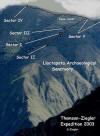|
Date : 08-11-2003 Source : Reuters
Using infrared aerial photography to penetrate the forest canopy, the team led by Briton Hugh Thomson and American Gary Zeigler located the ruins at Llactapata 50 miles northwest of the ancient Incan capital, Cusco.
The site was first mentioned by explorer Hiram Bingham, the discoverer of Machu Picchu, in 1912. But he was very vague about its location, and the ruins have lain undisturbed ever since. After locating the city from the air, the expedition used machetes to hack through the jungle to reach it, 9,000 feet up the side of a mountain.
They found stone buildings including a solar temple and houses covering several square miles in the same alignment with the Pleiades star cluster and the June solstice sunrise as Machu Picchu, which was a sacred center.
Not only was Llactapata probably a ceremonial site in its own right, excavations suggested that it might also have acted as a granary and dormitory for its sacred neighbor, he added.
The Incas abandoned their towns and cities and retreated from the treasure-hunting Spanish invaders after the Conquistadors captured and executed the last Incan leader, Tupac Amaru, in 1572.
Some of the cities have since been rediscovered, but many more are believed to lie hidden in the dense jungle, almost impossible to detect without new technology or a chance encounter. Last year, the expedition found another lost Incan town at Cota Coca, about 60 miles west of Cusco.
He said the use for the first time of an infrared camera to locate a set of ruins from the air had been a breakthrough, but one that did not make the humble machete redundant.
|

